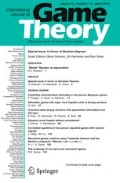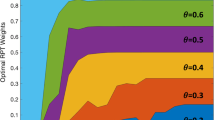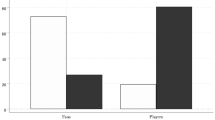Abstract
Two standard schemes for awarding a prize have been examined in the literature. The prize is awarded \((\pi _{D})\) deterministically: to the contestant with the highest output; \((\pi _{P})\) probabilistically: to all contestants, with probabilities proportional to their outputs. Our main result is that if there is sufficient diversity in contestants’ skills, and not too much noise on output, then \(\pi _{P}\) will elicit more output on average than \(\pi _{D}\). Indeed if contestants know each others’ skills (the complete information case) then the expected output at any Nash equilibrium selection under \(\pi _{P}\) exceeds that at any individually rational selection under \(\pi _{D}\). If there is incomplete information, the inequality continues to hold when we restrict to Nash selections for both schemes.
Similar content being viewed by others
Notes
This terminology is from Moldovanu and Sela (2001).
The total demand for gold is \(px_{1}+\cdots +px_{n}\) which must equal the supply y.
Consider, as in Dubey and Sahi (2012), the set of all possible probabilistic prizes that are based on outputs. (This set includes both \(\pi _{P}\) and \(\pi _{D}\) as particular elements.) The proportional prize is the only one in the set which is non-manipulable in the following sense: if an agent pretends to be several agents by splitting his output to be sent out in different names, this can be of no benefit to him; nor can several agents benefit by merging their outputs and pretending to be one agent (see Frutos 1999).
This is not to say that there will not be other circumstances where the same result holds, or yet others where it is reversed. Our analysis is far from being comprehensive, and it is our hope that this paper will stimulate further inquiry into the relative merits of \(\pi _{P}\) and \(\pi _{D}\).
i.e., productive skill, cost of effort, valuation of the prize.
Such a “principal” may even be in a position to modify \(\pi \) away from \(\pi _{P}\) or \(\pi _{D}\) based on some information regarding the domain of characteristics of his “agents”. In Dubey and Sahi (2012) we examine “optimal” \(\pi \) in certain settings.
Though commensurate always with their outputs, and never as a bonanza!
This list is indicative and by no means exhaustive.
Which is not so unnatural an assumption when there are a few discrete levels of effort (rather than continuous effort).
Going beyond our model, if one were to grant that skill is not rigidly fixed for individuals, but is a dynamic thing which gets (willy nilly) enhanced by their effort, then the superiority of \(\pi _{P}\) over \(\pi _{D}\) may be rephrased in more dramatic terms: too much accuracy in reporting performance, i.e., in certifying the underlying skill of the agents, can inhibit the very evolution of that skill.
It has however been pointed out in Fu and Lu (2007)—and in turn to us by an anonymous referee—that, with special assumptions on the stochasticity of outputs (essentially that the noise term be multiplicative, and i.i.d. across agents), \(\pi _{D}\) (with noise) can resemble \(\pi _{P}\) (without noise). But we are not aware of any analysis of \(\pi _{P}\) with noise (i.e., in the presence of moral hazard).
We are once again grateful to an anonymous referee for drawing our attention to this literature.
Even when, in a planned sequel to this paper (corresponding to the second half of Dubey and Sahi (2012)), we consider a family of contests from which a “principal” or “contest-designer” must choose the optimal, we deliberately restrict attention to those \(\pi \) where he observes only the outputs and not the skills of the contestants. (The contestants themselves may, or may not, know each others’ skills as is the case in our current paper.) The reason for this restriction is partly realism; and partly it also stems from the desire to keep contests “simple” and “playable”, and to steer clear of the complications that must inevitably arise when one tries to elicit characteristics from strategic contenders, such as their incentive to reveal the truth, or—even more fundamentally—just the complexity of the strategies needed to describe their skills (a whole probability distribution!). The study of such complicated contests may well be useful in special settings, but lies outside the purview of this paper.
This space X is defined after fixing the domain and range of \(\tau \). It will shortly be taken to be measurable. A key scenario we have in mind is that X is a finite set, as spelled out in Remark 3 below. Or else one can confine attention to random variables \(\tau \) which are characterized by finitely many parameters, so that \((\delta ,\tau ,v)\) is a finite-dimensional vector; and then the Euclidean space generates the Borel sets. In this case the space X consists of all \((\delta ,\tau ,v)\) that satisfy (1) and (2) of Assumption 1. More generally, without such restrictions, the Levy–Prokhorov metric on the random variables \(\tau \) is understood to define the Borel sets.
i.e., there is zero probability for the event that \(\tau (e)\) takes values outside the open interval (de, De).
Given \(\chi =(\delta ^{n},\tau ^{n},v^{n})_{n\in N}\), and a vector \(\alpha \equiv (\alpha ^{n})_{n\in N}>>0\) of positive scalars, let \(\chi (\alpha )\equiv (\alpha ^{n}\delta ^{n},\tau ^{n},\alpha ^{n}v^{n})\). Then the games \(\Gamma _{\pi }(\chi )\) and \(\Gamma _{\pi }(\chi (\alpha ))\) are “strategically equivalent” and all our solution concepts remain the same for them. So w.l.o.g., scaling utilities appropriately, one could imagine \(v^{n}=v\) for all \(n\in N\).
However notice that, in the special case of binary effort levels, i.e., \(E=\left\{ 0,1\right\} \), we automatically have \(e_{min}= 1\) in Theorem 5, producing a sharp bound without further ado.
We believe that conditions (a) and (b) are pertinent in many real world situations. Notice that they straightforward to interpret (and corroborate) in terms of the exogenous data \(\{ \tau ^{n}(1)\} _{n\in N}\) of the model, since the elite set \(K({\chi })\) is defined directly in terms of that data (see Eq. (5)).
If \(v\le 1\) then the only NE in \(\Gamma _{\pi _{D}}^{*}\) or \(\Gamma _{\pi _{P}}^{*}\) is that both agents never work (since effort 1 costs 1 which cannot be compensated by any probability of winning the prize).
But it should be emphasized that one needs to go beyond the binary model with effort levels 0, 1 in order for the example to work. The reason for this is clear. Suppose that there is large noise. Then if both contenders choose effort 1 they are roughly equal and each wins the prize with probability approximately 1 / 2 regardless of whether \(\pi _{D}\) or \(\pi _{P}\) is in play; moreover if one of them unilaterally deviates from effort 1 to 0 then he wins with probability 0. Thus the incentive to work is about the same under either prize. For \(\pi _{D}\) to outperform \(\pi _{P}\) in a convincing sense in the presence of large noise, there need to be real effort levels below 1 ( note: 0 is non-participation rather than low effort) at which the deviator loses more under \(\pi _{D}\) than under \(\pi _{P}.\)
The measure \(V_{\pi }\) is used in Dubey and Sahi (2012) to compare not just \(\pi _{P}\) and \(\pi _{D}\), but to rank order a class of schemes \(\pi \) of which \(\pi _{P}\) and \(\pi _{D}\) are two instances.
Jensen’s inequality states that, if G is a convex function and X is a random variable, then \(\mathbb {E}G(X)\ge G( \mathbb {E}X).\) We apply it here to the convex function \(d/(X+D)\).
The elementary events of our model are \((e_{1},\ldots ,e_{N};t_{1} ,\ldots ,t_{N})\), i.e., N-tuples of efforts and outputs.
Any inequality, involving random variables, asserted to hold on \(E\cap F\) is understood to hold almost surely there.
For consider an agent who works at skill x and at skill y with \(y>x.\) For any realization of the rival’s \(\sigma ^{\prime }(z)\) he wins the prize with as much probability under y than under x because he is producing more at y. But when the rival’s skill \(z\in (x,y),\) an event that occurs with positive probability, he wins the prize with strictly more probability at y.
Strictly speaking, he chooses 0 (or, 1) if his skill is strictly below (or, above) c; and at c itself he can work with arbitrary probability \(0\le p\le 1\) since he is indifferent between working and shirking. But his choice of p does not affect either his rival’s response, since c occurs with zero probability.
also “the”, i.e., there is only one symmetric NE as the reader may easily verify.
References
Anton J, Yao D (1992) Coordination in split award auctions. Q J Econ 107:681–701
Barut Y, Kovenock D (1998) The symmetric multiple prize all-pay auction with complete information. Eur J Political Econ 14:627–644
Baye M, Kovenock D, De Vries CG (1993) Rigging the lobbying process: an application of the all-pay auction. Am Econ Rev 83:289–294
Baye M, Kovenock D, De Vries CG (1994) The solution to the Tullock rent-seeking game when R is greater than 2: mixed strategy equilibriain and mean dissipation rates. Public Choice 81:363–380
Broecker T (1990) Credit-worthiness tests and interbank competition. Econometrica 58:429–452
Bulow J, Klemperer P (1999) The genenralized war of attrition. Am Econ Rev 89:175–189
Che YK, Gale I (1997) Rent dissipation when rent seekers are budget constrained. Public Choice 92:109–126
Che YK, Gale I (1998) Caps on political lobbying. Am Econ Rev 88:643–651
Clark D, Riis C (1998) Competition over more than one prize. Am Econ Rev 88:276–289
de Frutos MA (1999) Coalitional manipulations in a bankruptcy problem. Rev Econ Des 4(3):255–272
Dubey P, Geanakoplos J (2010) Grading exams: 100,99,98.. or A,B,C? Games Econ Behav 69(1):72–94 Special Issue in Honor of Robert Aumann
Dubey P, Haimanko O (2003) Optimal scrutiny in multi-period promotion tournaments. Games Econ Behav 42(1):1–24
Dubey P, Sahi S (2012) The Allocation of a Prize (Expanded), Working Paper, Department of Economics, Stony Brook University
Dubey P, Wu C (2001) When less scrutiny induces more effort. J Math Econ 36(4):311–336
Ellingsen T (1991) Strategic buyers and the social cost of monopoly. Am Econ Rev 81:648–657
Fu Q, Lu J (2007) Unifying Contests: from Noisy Ranking to Ratio-Form Contest Success Functions. Munich Personal RePEc Archive
Glazer A, Hassin R (1988) Optimal contests. Econ Inq 26:133–143
Green J, Stokey N (1983) A comparison of tournaments and contracts. J Political Econ 91(3):349–364
Hanming F (2002) Lottery versus All-pay Auction Models of Lobbying. Public Choice, pp 351-371
Hart E, Avrahami J, Kareev Y The strong, the weak and lady luck: competitive behavior moderated by inequality and noise in the winner resolution rule (submitted for publication)
Hillman AL, Riley JG (1989) Politically contestable rents and transfers. Econ Politics 1:17–39
Krishna V, Morgan J (1998) The winner-take-all principle in small tournaments. Adv Appl Microecon 7:61–74
Lazaer E, Rosen S (1981) Rank order tournaments as optimum labor contracts. J Political Econ 89:841–864
Moldovanu B, Sela A (2001) The optimal allocation of prizes in contests. Am Econ Rev 91(3):542–558
Nalebuff B, Stiglitz J (1983) Prizes and incentives: towards a general theory of compensation and competition. Bell J Econ 14:21–43
Nti KO (1999) Rent-seeking with asymmetric valuations. Public Choice 98(3–4):415–430
Rosen S (1986) Prizes and incentives in elimination tournaments. Am Econ Rev 76:701–715
Rowley CK (1991) Gordon Tullock: entrepeneur of public choice. Public Choice 71:149–169
Rowley CK (1993) Public Choice Theory. Edward Elgar Publishing, Aldershot, UK
Tullock G (1980) Efficient rent-seeking. In: Buchanan JM, Tollison RD, Tullock G (eds) Toward a theory of rent-seeking society. Texas A. & M. University Press, College Station
Author information
Authors and Affiliations
Corresponding author
Additional information
We are grateful to two anonymous referees, and especially to Ori Haimanko, for very useful comments and references.
Rights and permissions
About this article
Cite this article
Dubey, P., Sahi, S. Eliciting performance: deterministic versus proportional prizes. Int J Game Theory 45, 239–267 (2016). https://doi.org/10.1007/s00182-015-0503-9
Accepted:
Published:
Issue Date:
DOI: https://doi.org/10.1007/s00182-015-0503-9
Keywords
- Principal
- Contestant
- Proportional and deterministic prizes
- Complete and incomplete information
- Nash equilibrium
- Individually rational strategies




